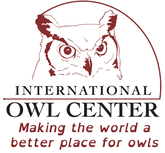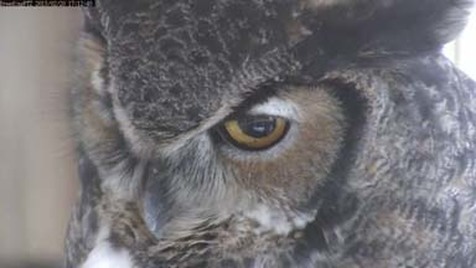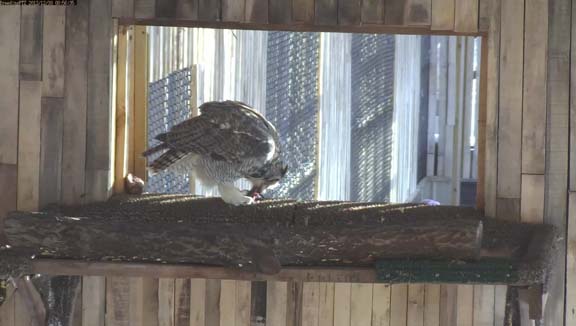History of Rusty and Iris
Rusty was hit by a car as an adult and admitted to the Raptor Education Group, Inc. in Antigo, WI around 2007. He suffered trauma to his brain and right eye, as well as broke his left radius. Although his wing healed, he was permanently blind in his right eye so he wouldn't be able to hunt well enough to provide for a family in the wild. His bad eye had to be removed in 2013.
Iris was admitted to the Raptor Education Group as an adult with a puncture to her right eye around 2006. Her injury distorted her pupil and left scar tissue on her cornea, making it unlikely she can see out of her right eye well enough to survive well in the wild.
While living at the Raptor Education Group in a cage with many other Great Horned Owls, Rusty and Iris started preferentially "hanging out" together, so Executive Director Marge Gibson thought they would likely make a good breeding pair and offered them to Karla for her research project.
It took several years before their new, spacious home in Houston was built. In the meantime they served as foster parents at REGI for an orphaned owlet in 2009. They moved to Houston in October of 2010.
Although they copulated starting in February of 2011, they did not lay eggs that first year. This probably had to do with not being settled enough in their new home and Scarlett Owl Hara, a wild, unmated female Great Horned Owl that harassed them daily for months, apparently trying to convince Rusty to be her mate.
Scarlett found her own mate in the fall of 2011 and Rusty and Iris laid eggs in late January 2012. Iris incubated dutifully, but the eggs failed to hatch. An examination of the eggs revealed fully developed chicks that died days before hatching. Arnold van den Burg, an expert on unhatched eggs, suspects the eggs overheated based on photos of the unhatched chicks.
Rusty and Iris hatched three eggs in 2013 and the owlets were named Pandora, Patrick and Patience. They were released to the wild and tracked using telemetry in the fall of 2013.
In 2014 they hatched Ruby and Rupert. Ruby works as educational ambassadors for the International Owl Center and Rupert was eventually transferred to another facility.
In 2015 and 2016 we removed Rusty and Iris' eggs so they did not produce young.
In 2017 Rusty and Iris hatched Sheldon and Sequoia. They were placed at an other facility after they developed their adult vocalizations.
Due to Rusty's declining vision in his one remaining eye and the stress and potential for injury to his eye from raising pesky juvenile owls, Rusty and Iris retired from breeding in 2018. Rusty's vision continued to steadily decline to the point of blindness, and he earned his angel wings on January 31, 2022.
Iris was admitted to the Raptor Education Group as an adult with a puncture to her right eye around 2006. Her injury distorted her pupil and left scar tissue on her cornea, making it unlikely she can see out of her right eye well enough to survive well in the wild.
While living at the Raptor Education Group in a cage with many other Great Horned Owls, Rusty and Iris started preferentially "hanging out" together, so Executive Director Marge Gibson thought they would likely make a good breeding pair and offered them to Karla for her research project.
It took several years before their new, spacious home in Houston was built. In the meantime they served as foster parents at REGI for an orphaned owlet in 2009. They moved to Houston in October of 2010.
Although they copulated starting in February of 2011, they did not lay eggs that first year. This probably had to do with not being settled enough in their new home and Scarlett Owl Hara, a wild, unmated female Great Horned Owl that harassed them daily for months, apparently trying to convince Rusty to be her mate.
Scarlett found her own mate in the fall of 2011 and Rusty and Iris laid eggs in late January 2012. Iris incubated dutifully, but the eggs failed to hatch. An examination of the eggs revealed fully developed chicks that died days before hatching. Arnold van den Burg, an expert on unhatched eggs, suspects the eggs overheated based on photos of the unhatched chicks.
Rusty and Iris hatched three eggs in 2013 and the owlets were named Pandora, Patrick and Patience. They were released to the wild and tracked using telemetry in the fall of 2013.
In 2014 they hatched Ruby and Rupert. Ruby works as educational ambassadors for the International Owl Center and Rupert was eventually transferred to another facility.
In 2015 and 2016 we removed Rusty and Iris' eggs so they did not produce young.
In 2017 Rusty and Iris hatched Sheldon and Sequoia. They were placed at an other facility after they developed their adult vocalizations.
Due to Rusty's declining vision in his one remaining eye and the stress and potential for injury to his eye from raising pesky juvenile owls, Rusty and Iris retired from breeding in 2018. Rusty's vision continued to steadily decline to the point of blindness, and he earned his angel wings on January 31, 2022.







